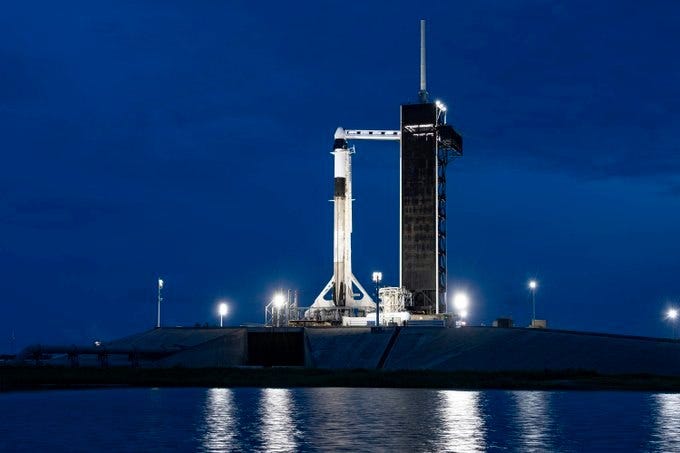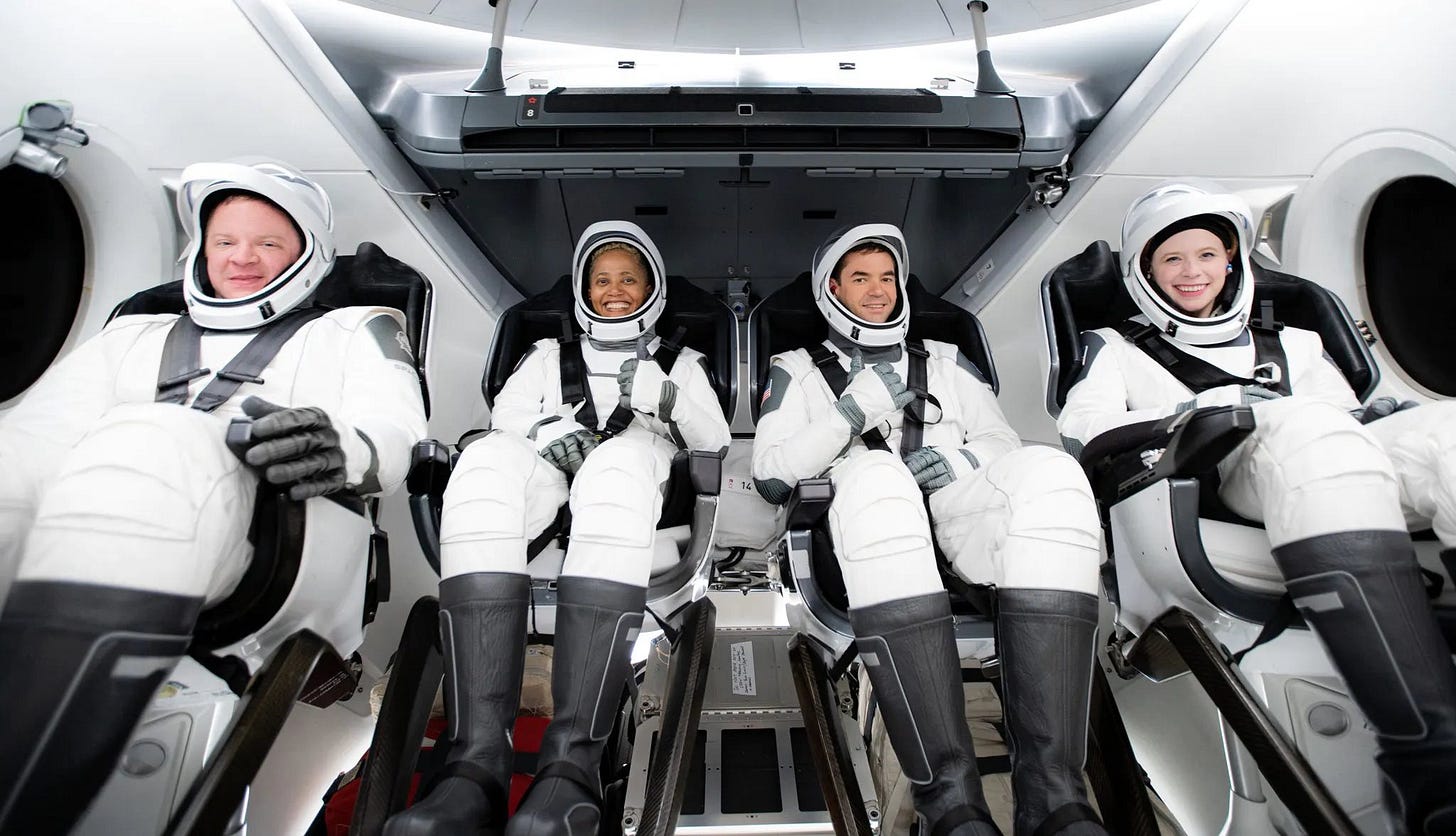It’s easier than ever to get to space
Two space stories this week prove the point

September 15, 2021
It's a first. An entirely civilian crew will rocket into orbit aboard a SpaceX Falcon 9 for three days of weightlessness orbiting earth. This flight, set for later today, leaves me with a couple of takeaways.

The Inspiration 4 crew before launch on SpaceX Falcon 9. (Credit: Inspiration4)
AUTONOMY
First, autonomous systems of spacecraft are far superior to those of cars. The crew of four of Inspiration 4 won’t have to do much controlling of the spacecraft during their trip. The Falcon 9 rocket and Dragon capsule are programmed to control the entire mission from liftoff to splashdown. The only thing the four will have to do is get in and out of their pressure suits, buckle into their seats, and take care of their bodily functions for their three days in space. Autonomy works so well in space because there aren’t bicyclists and children running through crosswalks. There’s not a lot up there in space, relatively speaking, to bump or crash into.
ACCESSIBILITY
Second, this says a lot about how space travel has become more accessible if you have the money. Entrepreneur, adventurer, and pilot Jared Issacman bought the flight and has tried to make inspirational and charitable. He donated $100 million to St. Jude Hospital hoping to raise another $100 million before splashdown. The 38 year old, who has a lot of stick time in aircraft including fighter jets and will act as the commander. He picked the three others to fly with him; a teacher, a nurse at St. Jude, and an engineer. Just average folks with no experience in the the space program.

Crew members experience a few seconds of weightlessness during a training flight. (Credit: Inspiration4)
I hope the crew members like each other. The Dragon capsule is big enough to move around in, but there is no private space. In fact, there is about as much room as the four flyers experienced in the back of an aircraft that created weightlessness for a few seconds during their training.
This private mission was put together in about 10 months. The crew was trained by SpaceX in a compressed format (compared to NASA astronaut training at SpaceX) which included a 30-hour stint in a Dragon capsule simulator. The four spacefarers say they are ready and have faith in SpaceX and its hardware. Issacman pushed for a high orbit, and he got it. They will fly to 575 kilometers above earth which is higher than the space station and even the Hubble telescope.

Crew members at SpaceX headquarters in Hawthorne, CA. (Credit: Inspiration4)
This is not the first mission of civilians reaching orbit, or tourists in space. In fact, the current NASA Administrator, Bill Nelson, flew on the space shuttle when he was serving in the US Senate. More of these civilian flights to orbit are coming. NASA is planning for two a year. They are called PAMs (Private Astronaut Missions).
Good luck to Inspiration 4. I will be watching.

(Credit: Inspiration4)
TO THE MOON
A small Seattle company that carries micro-satellites to space says it can now go to the moon. I will be writing more about ride sharing missions carrying satellites to space, but there was a development this week worth touching on.
The Seattle company, Spaceflight. has just announced its small Sherpa spacecraft now has the ability to use the moon to put satellites in orbit.

Example of how Spaceflight's Sherpa vehicle could circle moon before deploying satellites in GEO. (Credit: Spaceflight)
The new Sherpa ES (Escape) will fly its first mission late next year. The Sherpa will use the slingshot of the moon’s gravity to come back toward earth and drop off satellites in GEO (Geosynchronous Earth Orbit).
TO GEO
GEO is the orbit that is high enough and fast enough that a satellite, in essence, remains above the same piece of earth. A lot of companies and governments want to be in GEO for earth observation. GEO is much harder to get to than LEO (Low Earth Orbit). Spaceflight believes it will be a lucrative market. Since it is flying around the moon, Sherpa also has the ability to drop off a satellite in lunar orbit.
Spaceflight’s Vice President of Engineering Phil Bracken tells me that using the moon slingshot makes it faster and requires less energy (and therefore less money) to put a satellite in GEO. It could mean a savings of 25-30% in energy.

Sherpa-ES with fuel tanks and satellites attached. Sherpa-ES flight path around the moon and back to GEO to deploy satellites. (Credit: Spaceflight)
THE SPACECRAFT
The Sherpa may not look like what you might visualize as a spacecraft. It’s shaped like a disk, about 5 feet in diameter and 18 inches tall. It can holds satellites on its circumference. On this just announced mission, the Sherpa will carry what has been dubbed a “gas station in space,” a satellite refueling vehicle, built by Orbit Fab, which will be released in GEO after traveling around the moon.
Spaceflight has pushed development of its Sherpa quickly, developing this model is less than a year. “It’s a pretty remarkable mission to try in this amount of time,” Bracken says. He adds, “we are feeling the wind behind our sails.”
On to the moon (around it at least)!
It is getting easier to get to space.


